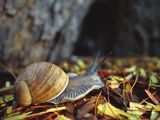Matter Recycles Again and Again but Energy Passes Through an Ecosystem Only Once
Living things need energy to grow, exhale, reproduce, and motility. Energy cannot be created from nothing, so it must be transferred through the ecosystem. The main source of free energy for well-nigh every ecosystem on Earth is the sun. Primary producers use energy from the sun to produce their own food in the class of glucose, and and so chief producers are eaten by primary consumers who are in plough eaten by secondary consumers, and so on, so that free energy flows from one trophic level, or level of the nutrient chain, to the next. The easiest way to demonstrate this energy menstruum is with a food concatenation. Each link in the concatenation represents a new trophic level, and the arrows show energy being passed along the chain. At the bottom of a food chain is always the chief producer. In terrestrial ecosystems nearly primary producers are plants, and in marine ecosystems, most principal producers are phytoplankton. Both produce most the nutrients and energy needed to back up the balance of the food chain in their respective ecosystems. All the biomass generated by chief producers is called gross main productivity. Net primary productivity is what is left over later on the primary producer has used the free energy it needs for respiration. This is the portion that is bachelor to be consumed by the primary consumers and passed up the nutrient chain. In terrestrial ecosystems, primary productivity is highest in warm, wet places with plenty of sunlight, like tropical forest regions. In contrast, deserts have the lowest primary productivity. In marine ecosystems, primary productivity is highest in shallow, food rich waters, such equally coral reefs and algal beds. To evidence the period of energy through ecosystems, nutrient chains are sometimes drawn as free energy pyramids. Each pace of the pyramid represents a different trophic level, starting with principal producers at the bottom. The width of each footstep represents the charge per unit of energy period through each trophic level. The steps get smaller further up the pyramid considering some of that energy is inverse to a course that cannot be consumed by organism at the side by side higher stride in the food chain. This happens at every step of the pyramid. Not all of the energy generated or consumed in one trophic level will be available to the organisms in the side by side higher trophic level. At each level, some of the biomass consumed is excreted equally waste product, some energy is changed to oestrus (and therefore unavailable for consumption) during respiration, and some plants and animals die without being eaten (meaning their biomass is non passed on to the side by side consumer). The waste and dead matter are broken down by decomposers and the nutrients are recycled into the soil to be taken up again by plants, only nearly of the energy is changed to estrus during this procedure. On average, only about ten percent of energy stored as biomass in a trophic level is passed from one level to the next. This is known as "the 10 per centum rule" and it limits the number of trophic levels an ecosystem can support.

Primary consumers, like the Giant African land snail (Achatina fulica), eat primary producers, like the plants the snail eats, taken energy from them. Similar the chief producers, the master consumers are in turn eaten, but by secondary consumers. This is how energy flows from one trophic level to the next.
Photograph by Cyril Ruoso/Minden Pictures
biomass
Substantive
living organisms, and the energy contained within them.
decomposer
Noun
organism that breaks down dead organic material; also sometimes referred to every bit detritivores
Noun
community and interactions of living and nonliving things in an area.
Noun
group of organisms linked in order of the food they eat, from producers to consumers, and from prey, predators, scavengers, and decomposers.
organism
Noun
living or once-living matter.
Noun
process by which plants plow h2o, sunlight, and carbon dioxide into water, oxygen, and elementary sugars.
phytoplankton
Substantive
microscopic organism that lives in the body of water and can convert lite energy to chemical energy through photosynthesis.
primary consumer
Substantive
organism that eats producers; herbivores.
primary producer
Noun
organisms, such as plants and phytoplankton, that can produce their own food through photosynthesis or chemosynthesis; also called autotrophs.
chief productivity
Noun
rate at which autotrophs such as plants use solar or chemical energy to abound and create new life.
respiration
Noun
animate.
secondary consumer
Noun
organism that eats meat.
trophic level
Substantive
one of three positions on the nutrient chain: autotrophs (kickoff), herbivores (second), and carnivores and omnivores (third).
Source: https://www.nationalgeographic.org/encyclopedia/energy-transfer-ecosystems/
0 Response to "Matter Recycles Again and Again but Energy Passes Through an Ecosystem Only Once"
Post a Comment